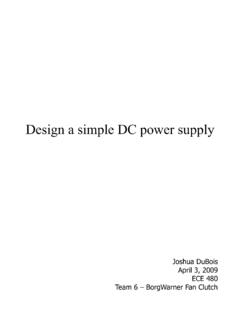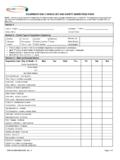Transcription of RE100 TECHNICAL CRITERIA
1 RE100 TECHNICAL CRITERIA 1 RE100 TECHNICAL CRITERIA Date of publication: March 22nd, 2021 RE100 TECHNICAL CRITERIA 2 VERSIONS CONTROL Version No. Revision date Revision Summary April 27th 2016 First public version January 2018 Minor edits of the TAG members names list and formatting edits March 22nd 2021 Minor edits about reporting (point 1) Additional information on Third party verification of consumption (point 2) Updates of the Energy sources and technologies: additional specifications on biomass and hydropower (point 3) Updates of the Options for renewable electricity procurement: two new options have been added (7. And 8.)
2 Additional information on Making credible claims (point 4, previously called Making Unique Claims ) New reference to the external document RE100 Market Boundary CRITERIA document version of May 2019 The details on how to make claims for each sourcing options have been moved to the table in the Annexure New information on Active vs. Passive sourcing of renewable electricity (point 6) and explanations about the two newly accepted procurement options (point and ) New text about the RE100 materiality threshold (point 7), taken from the Materiality Threshold document version of December 2019 New information about Maximizing impacts (point 8) Minor edits to the TAG members name list New Annexure with definitions of each of the sourcing option accepted by RE100 and explanations on how to make credible claims for each of them.
3 RE100 TECHNICAL CRITERIA 3 TECHNICAL NOTE ON RENEWABLE ELECTRICITY OPTIONS 1. PURPOSE OF THE RE100 CRITERIA The RE100 CRITERIA define what counts as sourcing renewable electricity for the purpose of participation in the RE100 campaign. This document outlines the options available to companies making progress towards the RE100 Commitment to 100% renewable electricity consumption. The renewable electricity market is dynamic and significantly varies country by country. To reflect this, RE100 may introduce electricity accounting and reporting rules, provide regional or national context, and provide further briefings on emerging best practices. The CRITERIA are set by the RE100 TECHNICAL Advisory Group in consultation with the companies in the campaign and with the approval of the RE100 Project Board.
4 2. THE RE100 COMMITMENT TO 100% RENEWABLE ELECTRICITY Public commitment RE100 companies make a public commitment to secure 100% of their electricity from renewable sources. The commitment covers electricity consumed from self-generation and electricity procured from a supplier or physical electricity market. For the purpose of the RE100 campaign, for a company to be considered 100% renewable, it must procure or self-produce 100% of its electricity throughout its entire operations from renewable sources. Organizational boundaries For more information on what counts as the entire operations of a company for the RE100 commitment, please refer to the RE100 Joining Criteria1 and the materiality threshold in Section 5 below.
5 Self-generation and purchases RE100 companies can achieve 100% renewable electricity use by making claims to: Production and use of renewable electricity from their own facilities. A company may consume renewable electricity that it generates. These facilities can be grid-connected and onsite or offsite, or entirely off the grid. Procured renewable electricity sourced from generators and suppliers in the market. This includes direct purchases from specific generators ( power purchase agreements), which can be located onsite or offsite. It also includes retail purchases from suppliers and utilities as retail product, and the procurement of stand-alone ( unbundled ) energy attribute instruments.
6 Transparent reporting Companies joining RE100 commit to reporting on their renewable electricity consumption and, where necessary, renewable electricity generation on an annual basis at a country level. Accounting and reporting of electricity consumption shall follow the principles and rules of the RE100 reporting guidance documents, which will be reviewed annually to reflect changes in the renewable electricity market. Third party verification of consumption, and where necessary, generation of renewable electricity is required. in accordance with a renewable electricity standard, where available. There are different levels of verification such as verification of renewable electricity generation, sales, and consumption.
7 Companies may use third-party verification of renewable electricity sales ( Green-e certification) and scope 2 GHG emissions (via GHG Protocol Corporate Standard) provided it meets the requirements outlined in this document. 1 RE100 TECHNICAL CRITERIA 4 3. ENERGY SOURCES AND TECHNOLOGIES RE100 considers renewable the electricity generated from geothermal, solar, sustainably sourced biomass (including biogas), hydropower and wind energy sources. Biomass and hydropower can play a role in decarbonization provided they are created and used sustainably. RE100 recommends using standards to secure sustainability claims associated with the use of biomass and hydropower.
8 The following standards/guidance can for instance be used: the ISO 13065:2015 (specifies principles, CRITERIA and indicators for the bioenergy supply chain to facilitate assessment of environmental, social and economic aspects of sustainability), the Green-e Renewable Energy Standard for Canada and the United States, and the Low Impact Hydropower Institute (LIHI). The TECHNICAL Advisory Group will study the environmental and social sustainability of these technologies and may introduce related recommendations and CRITERIA as consensus around best practices develop. 4. MAKING CREDIBLE CLAIMS At a minimum, RE100 defines renewable electricity consumption as the ability to make unique claims on the use of renewable electricity generation and its attributes.
9 RE100 members must be able to demonstrate that they have an exclusive claim to use of unique renewable electricity generation to meet all its reported renewable electricity usage. Typically, this means ownership of the generation attributes ( energy attribute certificates [EAC]) associated with the generation. In markets without available renewable energy certificate systems, companies may be able to use other contractual instruments and arrangements between generators, suppliers, and users to ensure that no other entity may claim use or delivery of the same renewable electricity generation. The requirements for a credible RE usage claim and the CRITERIA for contractual allocation of attributes (including energy attribute certificates) are as follows: 1 Credible generation data; 2 Attribute aggregation; 3 Exclusive ownership (no double counting) of attributes; 4 Exclusive claims (no double claiming) on attributes; 5 Geographic market limitations of claims*; and 6 Vintage limitations of claims.
10 *For RE100 CRITERIA on geographic market limitations of claims please see the RE100 note on Market Boundary for Making Corporate Renewable Electricity Use Claims2. In general, for RE100 a country is a considered a market. These CRITERIA apply to all the procurement methods identified below as well as to others not outlined here. For further details on the requirements for a credible renewable electricity usage claim, RE100 members should refer the RE100 briefing on Making Credible Renewable Electricity Usage Claims3. Additional leadership CRITERIA may be required below or in the future for RE100 beyond these minimum requirements. 2 3 RE100 TECHNICAL CRITERIA 5 5.






